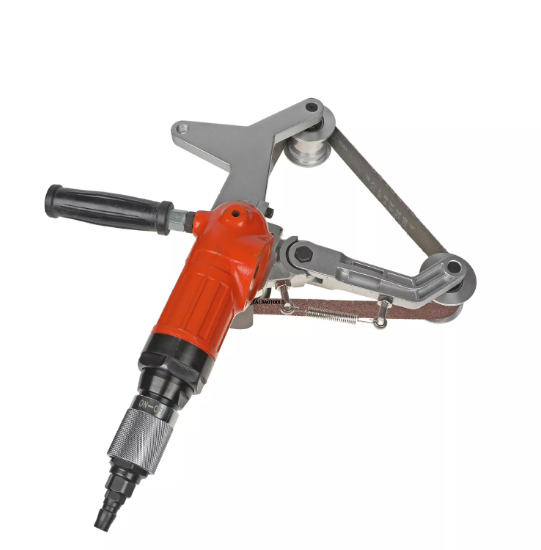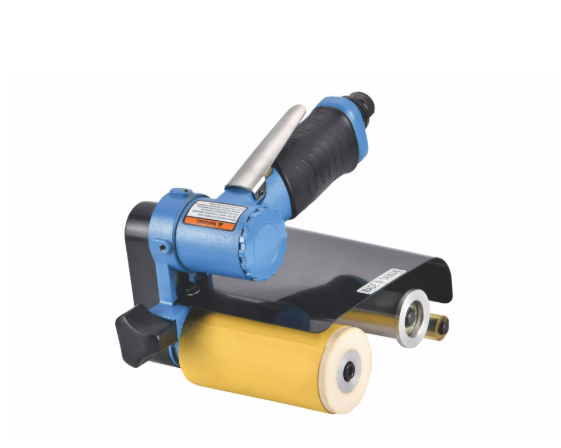

Views: 0 Author: Site Editor Publish Time: 2025-03-19 Origin: Site








Are you unsure which air belt sander is best for your project? Choosing the right tool can make a huge difference.
In this post, we'll explain what an air belt sander is and why picking the right one matters.
You'll learn about the different types of sanders, their key features, and how to select the perfect tool for your needs.

Selecting the right air belt sander is vital for achieving the best results in your projects. Using the wrong tool can lead to poor finishes, extra effort, and longer working hours.
It directly affects the quality of your work. The correct sander ensures smoother, more precise surfaces, and helps you complete tasks more efficiently. Understanding your project's requirements and materials will guide you in making the right choice.
Air belt sanders come in various types, each suited to specific tasks. Here’s a quick look at the main types:
Handheld Belt Sanders
These are compact and portable, ideal for smaller jobs or areas that require precision. They are great for smoothing edges, shaping curves, or sanding tight spots. These sanders are commonly used in woodworking and smaller metalworking projects.
Stationary Belt Sanders
Larger and more powerful, these sanders are mounted on a stand. They are perfect for heavy-duty sanding and larger workpieces. Stationary models often feature larger sanding surfaces, making them suitable for tasks like surface preparation or leveling large wooden panels.
Floor Belt Sanders
Specifically designed for sanding large floor areas, these sanders remove old finishes and smooth out uneven surfaces quickly. They are commonly used for refinishing wooden floors in both residential and commercial spaces.
Each type differs in size, design, and power. The right choice depends on your project’s scale and the material you’re working with.

When choosing an air belt sander, understanding its motor and power is crucial. Different tasks, like woodworking or metalworking, require different levels of power. For instance, metalworking tasks often need a more powerful motor, while light woodworking projects can be done with a less powerful one.
Motor horsepower plays a big role in the performance of your sander. A more powerful motor means faster sanding and smoother results. Speed control is equally important. Adjustable speed settings give you flexibility for various tasks and materials, from delicate surfaces to rough sanding.
The sanding belt and rollers are at the heart of your sander. The belt removes material, while the rollers help guide it smoothly. Choosing the right belt size is essential. Larger belts are great for bigger areas, while smaller belts offer better control for detailed work.
The material of the sanding belt also affects performance. For example, belts with finer grits are ideal for smooth finishes, while rougher grits are better for material removal.
Dust collection systems are essential for both safety and cleanliness. Sanding creates a lot of dust, which can be harmful to your lungs and create a messy workspace. A good dust collection system helps keep the air clean and your workspace visible.
Air belt sanders usually have two types of dust collection systems:
Dust bags: Simple and effective for small jobs.
Built-in dust ports: These connect to a shop vacuum, providing better dust removal, especially for larger tasks.
The right dust collection system will ensure a healthier work environment and better visibility as you work.
The size of the sanding pad is one of the first things to consider when choosing an air belt sander. Larger sanding pads cover more area and are ideal for bigger projects. These are perfect for flattening surfaces or removing large amounts of material quickly. However, they can be harder to maneuver in tight spaces.
Smaller sanding pads, on the other hand, offer better control for detail work. They are perfect for sanding smaller areas or intricate shapes, making them ideal for fine-tuning smaller projects.
Speed control is another important feature to look for. Different sanding tasks require different speeds. For instance, delicate surfaces or heat-sensitive materials need a slower speed to avoid damage. On the other hand, high-speed settings are great for removing material quickly or rough sanding tasks.
Having adjustable speed control gives you flexibility, allowing you to match the sander's speed to the material you're working on. Whether it's wood, metal, or plastic, you'll be able to get the job done more efficiently.
Comfort and ergonomics play a huge role in how easily you can use the sander for extended periods. Look for features like comfortable handles, well-balanced weight, and a secure grip. These features reduce hand strain and make the tool easier to handle, especially for longer projects.
Good ergonomics are essential, especially if you use the sander frequently. A well-designed tool reduces fatigue, allowing you to work comfortably and safely without risking injury.
When working on woodworking projects, you need a sander that can handle large surface areas and remove old finishes efficiently. Look for an air belt sander with a larger sanding pad, as it will cover more space and help you get the job done faster. A model with adjustable speed control is also essential for sanding delicate wood surfaces without causing damage.
For most woodworking tasks, a handheld belt sander is a good choice, as it offers flexibility and control. These sanders are lightweight, easy to maneuver, and ideal for smoothing wooden surfaces and edges.
Metalworking requires a more powerful sander. Power and speed are crucial for tasks like smoothing metal surfaces, removing rust, or deburring. Look for a sander that offers a high motor horsepower and a variable speed control for precise adjustments.
A stationary belt sander might be more suitable for heavy-duty metalworking tasks, as its larger surface area and stable design make it easier to work on bigger metal pieces. If you're working on smaller, intricate metal parts, a handheld sander with a fine-grit belt would be ideal.
For automotive work, especially when sanding and shaping metal body panels, you need a sander that can handle tough materials and tight spaces. A handheld belt sander with variable speed control is often the best choice for automotive bodywork, as it allows for precision and control when working on curved or uneven surfaces.
When selecting a sander for automotive use, consider a model with a high power rating and dust collection options to keep the workspace clean.
Floor sanding requires specialized tools, and a floor belt sander is the best option for refinishing wooden floors. These sanders are designed to cover large surface areas quickly and efficiently. Look for one with high mobility, a powerful motor, and effective dust collection to keep the work area clean.
Floor belt sanders are essential for heavy-duty sanding tasks, especially when you need to remove old finishes and smooth uneven surfaces. Choose this type of sander when working on large floor areas to get the best results.
Proper care is key to keeping your air belt sander working like new. Regular cleaning is essential to prevent dust buildup, which can damage the motor and decrease performance. Make sure to clean the dust ports and belts after each use.
You should also replace the sanding belts regularly, especially when they become worn out. Worn belts can cause the sander to perform poorly and can even damage the motor. To maintain optimal performance, check the motor for any signs of wear or overheating, and lubricate moving parts when needed.
To extend the lifespan of your air belt sander, avoid overloading the tool during use. Overworking the sander can cause the motor to overheat and lead to premature damage. Always match the sander’s power to the task at hand.
Using high-quality belts is also important for durability. Low-quality belts can wear out quickly, leading to more frequent replacements. Additionally, regularly check your air compressor for issues, as poor compressor performance can reduce the efficiency of your sander. Proper maintenance ensures the sander continues to perform well for years.
When using an air belt sander, always wear proper safety gear. This includes:
Goggles to protect your eyes from flying debris.
Dust mask to avoid inhaling harmful particles.
Hearing protection to reduce exposure to loud noise.
Wearing these items will keep you safe and comfortable while working.
Operating an air belt sander correctly is key to preventing accidents. Follow these best practices:
Keep both hands on the sander while in use for better control.
Always let the sander come to a complete stop before setting it down.
Maintain a firm grip, especially when sanding large surfaces.
Avoid common mistakes like pressing too hard on the tool or neglecting maintenance. These can cause the sander to overheat or work inefficiently.
Dust and debris are common when using an air belt sander. Here's how to minimize risks:
Ensure your sander has an effective dust collection system.
Use a vacuum attachment or a built-in dust bag to capture particles.
Work in a well-ventilated area to reduce dust buildup in the air.
By maintaining a clean workspace and using dust control systems, you'll protect both your health and your equipment.
Air belt sanders, like any tool, can experience issues during use. Here are some common problems and how to troubleshoot them:
Belt Slippage
If the belt keeps slipping off, check the tension and alignment. Tighten the tension and ensure the belt is properly aligned on the rollers.
Excessive Vibrations
Vibrations can occur if the sander is not balanced properly or if the belt is worn out. Try replacing the belt and ensure the sander’s components are tightly secured.
Power Loss
Power loss can happen if the motor is clogged with dust or the air supply is inconsistent. Clean the motor regularly and check for any blockages in the air compressor.
Over time, even the best air belt sanders will wear out. Here are signs it might be time for a replacement:
Frequent Repairs: If you're repairing it often, it's more cost-effective to replace the sander.
Decreased Performance: If it no longer sands efficiently or the motor struggles even with a new belt, it's time to upgrade.
Visible Damage: Cracks or worn-out components that can't be replaced may indicate the sander needs replacing.
Choosing the right air belt sander involves considering the tool's size, power, and intended use. Features like adjustable speed and dust collection are essential for safety and efficiency.
Before purchasing, assess your project's specific needs. Consider the material, project size, and the features you need for optimal performance.